Since a very long time, one thing that has remained constant in the business world is the need for advertising. And we all have a fairly good idea of what an advertisement looks like, be it a newspaper ad, a pamphlet, a billboard ad or a TV ad. However, from the printing press in the beginning to pop-up ads today, advertising has certainly changed with the times.
And then came the year 2020, which changed the fortunes and strategies of various industries. With accelerated digital transformation, businesses reshaped their functioning by diversifying and adapting to the prevalent market conditions. This has catalysed a change in consumer behaviour and made everyone more inclined towards the digital arena, hence, heralding the advent of a new era for the Indian economy.
Not surprisingly, the media and advertising sector witnessed a renaissance too.
Initially, there were quite a few bumps in the early phase of the lockdown. Brands were forced to cancel, delay and reschedule their advertising and media campaigns. Some corporations held back on their advertising expenditures and decided to utilise their funds more judiciously in other ways, while others adjusted their advertising spending throughout the lockdown period.
This caused the advertising sector to go down.
Overall, the Indian advertising industry currently stands at Rs 56,490 crores after witnessing a de-growth of 17.5 per cent over 2019 due to the pandemic.
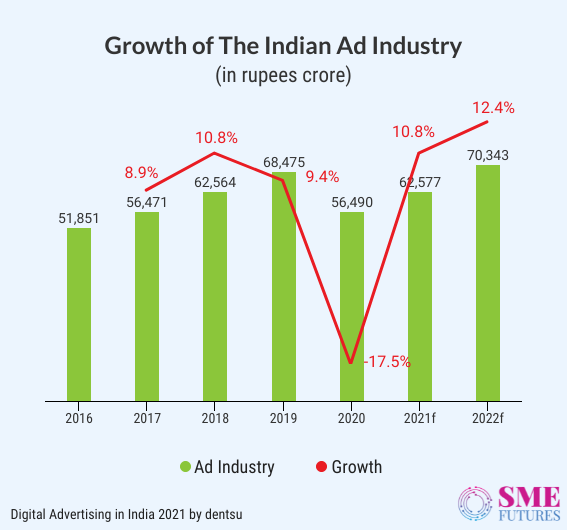
But interestingly, digital advertising is witnessing an upward surge.
The COVID-19 pandemic has only accelerated the adoption of the digital medium as a key advertising vehicle. According to a report titled ‘Digital Advertising in India 2021’ the digital advertising industry has grown by 15.3 per cent and reached Rs. 15,782 crores by the end of 2020. In 2019, it stood at Rs 13,683 crores. Infact, the digital medium has already overtaken print to become the second biggest AdEx medium in India and is fast catching up with TV AdEx numbers. Moving further, the digital media is expected to grow by 20 per cent to reach a market size of Rs. 18,938 crores by 2021 and with a CAGR of 22.47 per cent to reach Rs. 23,673 crores by 2022.
Dentsu India CEO Anand Bhadkamkar comments, “The pandemic created a demand for e-commerce purchases in tier-II and tier-III cities and brought in a behavioural shift in elderly consumers. Customers from tier-II and tier-III cities began to prefer buying from online retailers offering delivery at flexible timings while being cautious about safety and health during the pandemic; the elderly, meanwhile, gradually moved to using cashless digital payment methods instead of cash transactions. The result? The pandemic began to aggressively fuel digital adoption across the country leading to a 15.3% growth over the previous year. We, at Dentsu, expect 2021 to witness a colossal rise in digital advertising.”

The report by advertising major Dentsu, throws more light on the growth of digital advertising in 2020 and how the market has been reshaped over this one-year period. Let us take a look at some interesting statistics and the key trends that have led to a makeover of the digital advertising market and contributed to this paradigm shift.
Television is still the king
Last year many if not all consumers became digital consumers.
Due to a rapid shift of consumers to online channels, businesses also transformed themselves and built their advertisement strategies around the digital space. Thus, there is a huge upward surge in the time that people are spending in the digital space. As per the report, advertising spending in the digital arena has increased from 20 per cent in 2019 to a whopping 28 per cent in 2020.
However, the lockdowns have had a severe impact on the reach of mediums like print, out-of-home (OOH) and cinema, due to this drastic behavioural change in consumers. This resulted in a contraction of the media ad spend of print, OOH and cinema compared to 2019.
The print media in particular witnessed a significant fall in its market share. Its proportion declined from 29 per cent in 2019 to 25 per cent in 2020. But overall, this change could not dethrone the television industry from its pre-eminent position in the ad spend landscape.
It is still on top, thanks to the audience’s loyalty.
According to the study, television contributes the largest share of 41 per cent, i.e., Rs. 23,201 crores to the Indian advertising market. While digital follows at 28 per cent with Rs. 15,782 crores and print at 25 per cent with Rs. 13,970 crores.

Print, OOH, radio and cinema are expected to maintain the same market spending share this year as in the year 2020.
Social media has become the most preferred ad space
For brands, it has always been imperative to have an active social media presence to communicate with consumers, understand their needs and build trust. The pandemic has further strengthened this trend. Numerous businesses have gone online in 2020 and are engaging with their customers directly and creating avenues to cement their brand recall value.
This has created a wide window for the need for digital advertising.
Businesses are spending more out of their digital advertisement budgets on social media, making this format the strongest digital ad platform. It has been calculated that Indian consumers spend around 2-3 hours on social media a day, resulting in higher spending on social media platforms.
As per the numbers, the social media ad spend on digital is 29 per cent at Rs. 4,596 crores. This is followed very closely by online video, which contributes 28 per cent with around Rs. 4,366 crores, and the paid search spend is 24 per cent i.e… Rs. 3,725 crores. Spending on display banners stands at 16 per cent with Rs. 2,528 crores.
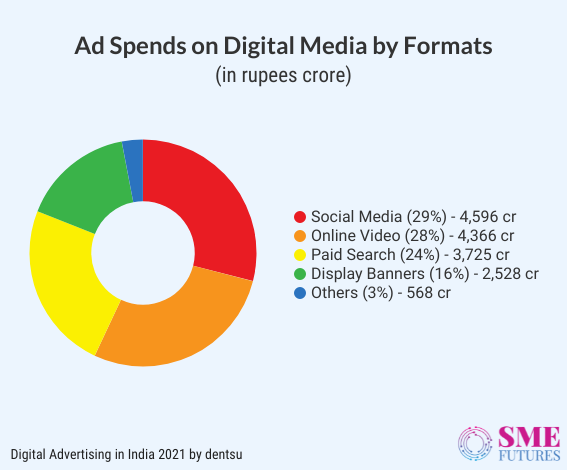
“There might be a shortfall in advertising growth in India – but the long-term prospects for digital advertising have never been better. This shift is not new for brands. It’s born out of customer-centricity,” mentions Gurjot Singh Shah, Senior VP & National Media Head, Dentsu WebChutney in the report.
“A majority of brands have found ways to start selling online and the existing ones have strengthened their digital businesses by going directly to the customer, thus reducing their dependence on the marketplace,” he said.
The report also mentions that there is a significant jump in online video spending as well. The spending ratio grew by 6 per cent from 22 per cent in 2019 to 28 per cent in 2020. The rapid growth of online video has shown that digital has evolved as a strong branding and creative medium in addition to being a performance behemoth historically.
FMCG makes more advertisements
The top three industry verticals with extravagant advertisement spends are—FMCG, e-commerce and consumer durables.
According to the report, the Indian FMCG sector spends the most on making advertisements and contributes 21 per cent, which is Rs 11,554 crores to advertisement spending. The e-commerce sector comes second with a contribution of 17 per cent and the consumer durables segment follows with 10 per cent at about Rs. 5,751 crores, to the advertising pie. The telecom, automotive and BFSI contribute 9, 7 and 5 per cent respectively to the ad expenditure space. Take a look at this infographic.
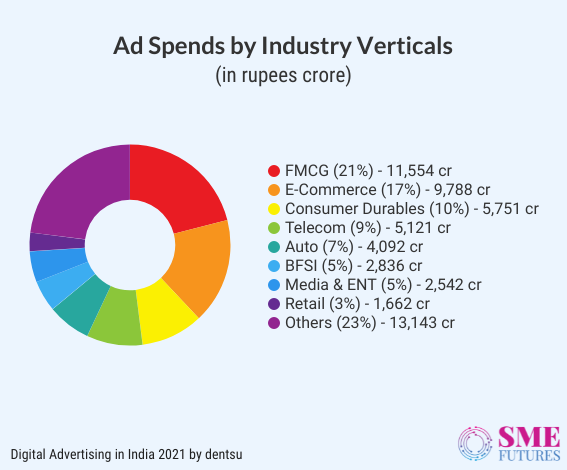
We should take an in depth look at how these verticals are spending their ad budgets on various media. Surprisingly, the FMCG sector still prefers television (64 per cent) as their medium as it has the widest reach. Whereas it spends 19 per cent on digital and 11 per cent on print ads.
For the e-commerce sector, the largest share of its media ad budget goes to television (45 per cent) followed by digital (39 per cent). The retail segment spends its maximum budget on print followed by digital. Meanwhile the automotive sector prefers advertising through the print media with 39 per cent of its media budget spending earmarked for that.
We can say that with the evolving need for digital ads, various sectors are hiking up their budgets for digital spending. The automobile sector increased its share of digital spending from 16 per cent in 2019 to 25 per cent in 2020. The telecom segment’s advertising expenditure share on digital increased from 35 per cent in 2019 to 40 per cent in 2020. This is mainly because Vodafone-Idea (Vi) launched its new branding campaign and the other telecom companies were also highly active, putting forth new launches during the second quarter.
Similarly, the BFSI segment’s spend share of digital advertising has increased from 42 per cent in 2019 to 57 per cent in 2020. The media and entertainment segments are also spending more on digital and reached 32 per cent in 2020 from 23 per cent in 2019.
2020 witnessed the growth of e-commerce advertising
2020 has witnessed an accelerated growth of e-commerce usage as more Indians of various age groups are shopping online more frequently than ever.
There is also a growing trend of online shoppers belonging to Tier II and Tier III cities and beyond, thus truly widening the reach of this platform. To attract such customers, e-commerce companies are using strategies like the use of the local language augmented by providing localized content and offers.
In addition to that, the advent of DSPs by e-commerce platforms and a higher focus on product search during the pandemic period has driven the evolution of e-commerce advertising in India.
Market forecasts say that by the end of 2020, the advertising expenditure on e-commerce platforms was Rs. 4,700 crores. Based on the current trajectory, the advertising spending on these platforms is expected to grow at a CAGR of 40 per cent.

Myntra received over 5 lakh shoppers over an end of season sale lasting 4 days and over 15 lakh products were sold during the first 12 hours of EORS. Nestle’s e-commerce revenue is 4 per cent. E-commerce companies including Flipkart and Amazon sold $4.1 billion (Rs. 29,000 crores) worth of goods during the October 15-21 period this year, up from $2.7 billion in 2019.
Statistics such as the fact that 229 million viewers tuned in on day one of IPL 2020, give more reasons for immersive partnerships opportunities to advertisers, says Salil Sadanandan, President, South Asia & EMEA, Kohler in the report.
“Today, marketing is not just about the 4Ps. It is about truly adapting to your customers’ needs as quickly as possible and meeting them where they are present. Brands are not outliers to culture and society but a part of it,” he postulates.
“We have been early adopters of digital platforms in the home décor space, and it has helped us remain in touch with consumers and engage with our customers even during the pandemic. Digital initiatives will remain intrinsic to our strategy going forward,” he adds.
The report also noted that e-commerce makes the highest contribution of 24 per cent (Rs. 3,782 crores) to the digital media ad industry followed by the consumer durables, FMCG and telecom sectors. Compared to the previous year, the share of the e-commerce segment has increased from 19 to 24 per cent, making it the highest contributor to the digital media ad spend pie. The key drivers in these sectors are the young demographic profile, leading to an improvement in internet penetration and government initiatives, subsequently generating a positive impact on the economic performance of the country.
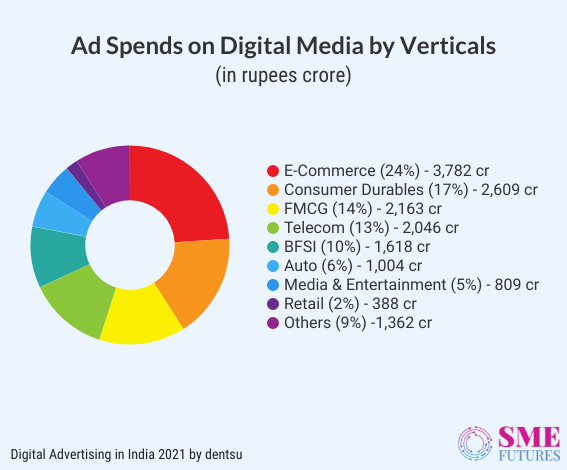
India’s online consumers are the big impetus
Over the last few years, India has become home to rapid digitization, with over 734 million users coming online at the end of October 2020. These users account for over 53 per cent of the nation’s population. This digital transformation was further catapulted as a result of the pandemic, which has been a once in a lifetime event for the majority of the world’s population and has altered our daily lives beyond imagination. For countless users, their initial internet foray began with a search. Just look at these statistics noted for April to July 2020 by Microsoft.
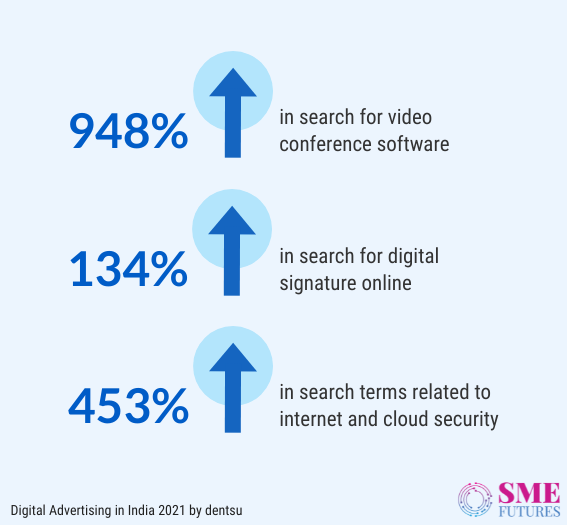
Not only this but from the comfort of their homes, consumers know exactly what they are looking for. This makes search ads the right channels to reach users. In 2020, most brands discovered and understood that search advertising ensures the visibility of brands in front of high intent consumers, thus digital advertising has been gaining prominence.
“While we experienced amplified value consciousness among consumers in this post-pandemic era, trust signals have become even more critical for consumer brands. In a category like life insurance, while we experienced a heightened willingness to pay for pure-risk cover plans, we also saw an increasing number of prospects researching and comparing our proposition & services with elongated conversion cycles. Curating campaigns around Core Cultural Insights, optimizing media mix for the Performance X Brand and leveraging organic content for enabling decision making has become more critical than ever before,” asserts Vaibhav Kumar, VP and Head, e-commerce & digital marketing, Max Life Insurance.
Going forward, it is estimated that by the end of 2022, 77 per cent of all digital media ad spending will be on mobile devices.
Stakeholders are adopting the digital advertising ecosystem to ramp up user experience and increase their reach and engagement with the help of mobile advertising. The evolving technology and use of AR/VR, voice, etc., on mobile devices has revolutionised the media and advertising industries. More people in India are becoming familiar with and adept at the usage of these technologies.











